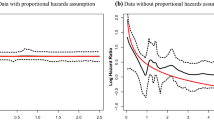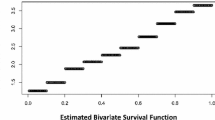Abstract
In the analysis of competing risks data, cumulative incidence function is a useful summary of the overall crude risk for a failure type of interest. Mixture regression modeling has served as a natural approach to performing covariate analysis based on this quantity. However, existing mixture regression methods with competing risks data either impose parametric assumptions on the conditional risks or require stringent censoring assumptions. In this article, we propose a new semiparametric regression approach for competing risks data under the usual conditional independent censoring mechanism. We establish the consistency and asymptotic normality of the resulting estimators. A simple resampling method is proposed to approximate the distribution of the estimated parameters and that of the predicted cumulative incidence functions. Simulation studies and an analysis of a breast cancer dataset demonstrate that our method performs well with realistic sample sizes and is appropriate for practical use.
Similar content being viewed by others
References
Chen K, Jin Z and Ying Z (2002). Semiparametric of transformation models with censored data. Biometrika 89: 659–668
Cheng SC, Wei LJ and Ying Z (1995). Analysis of transformation models with censored data. Biometrika 87: 867–878
Cox DR (1972). Regression models and life-tables (with discussion). J Roy Stat Soc Ser B 34: 187–220
Cummings FJ, Gray R, Tormey DC, Davis TE, Volk H, Harris J, Falkson G and Bennett JM (1993). Adjuvant tamoxifen versus placebo in elderly women with node-positive breast cancer: long-term follow-up and causes of death. J Clin Oncol 11: 29–35
Farewell VT (1982). The use of mixture models for the analysis of survival data with long-term survivors. Biometrics 38: 1041–1046
Farewell VT (1986). Mixture models in survival analysis: are they worth the risk. Can J Stat 14: 257–262
Fine JP (1999). Analyzing competing risks data with transformation models. J Roy Stat Soc Ser B 61: 817–830
Fine JP and Gray RJ (1999). A proportional hazards model for the subdistribution of a competing risk. J Am Stat Assoc 94: 496–509
Gray RJ (1988). A class of K-sample tests for comparing the cumulative incidence of a competing risk. Ann Stat 16: 1141–1154
Jeong J-H and Fine JP (2006). Direct parametric inference for the cumulative incidence function. Appl Stat 55: 1–14
Jin Z, Ying Z and Wei LJ (2001). A simple resampling method by perturbing the minimand. Biometrika 88: 381–390
Kalbfleisch JD and Prentice RL (2002). The statistical analysis of failure time data, 2nd edn. Wiley, New Jersey
Kaplan EL and Meier P (1958). Nonparametric estimation from incomplete observations. J Am Stat Assoc 53: 457–481
Klein JP and Andersen PK (2005). Regression modeling of competing risks data based on pseudovalues of the cumulative incidence function. Biometrics 61: 223–229
Kuk AYC and Chen C-H (1992). A mixture model combining logistic regression with proportional hazards regression. Biometrika 79: 531–541
Larson MG (1984). Covariate analysis of competing risks models with log-linear models. Biometrics 40: 459–469
Larson MG and Dinse GE (1985). A mixture model for the regression analysis of competing risks data. Appl Stat 34: 201–211
Lu W and Ying Z (2004). On semiparametric transformation cure models. Biometrika 91: 331–343
Maller R and Zhou X (2002). Analysis of parametric models for competing risks. Stat Sin 12: 725–750
Pepe MS (1991). Inference for events with dependent risks in multiple endpoint studies. J Am Stat Assoc 86: 770–778
Pepe MS and Mori M (1993). Kaplan-Meier, marginal or conditional probability curves in summarizing competing risks failure time data. Stat Med 12: 737–751
Pollard D (1990) Empirical processes: theory and applications, NSFCBMS Regional Conference Series in Probability and Statistics, vol 2. Institute of Mathematical Statistics and American Statistical Association, Hayward, CA
Prentice RL, Kalbfleisch JD, Peterson AV, Flournoy N, Farewell VT and Breslow NE (1978). The analysis of failure times in the presence of competing risks. Biometrics 34: 541–554
Sun L, Liu J, Sun J and Zhang M (2006). Modeling the subdistribution of a competing risk. Stat Sin 16: 1367–1385
Tsiatis AA (1975). A nonidentifiability aspect of the problem of competing risks. Proc Natl Acad Sci 72: 20–22
Author information
Authors and Affiliations
Corresponding author
Rights and permissions
About this article
Cite this article
Lu, W., Peng, L. Semiparametric analysis of mixture regression models with competing risks data. Lifetime Data Anal 14, 231–252 (2008). https://doi.org/10.1007/s10985-007-9077-6
Received:
Accepted:
Published:
Issue Date:
DOI: https://doi.org/10.1007/s10985-007-9077-6




